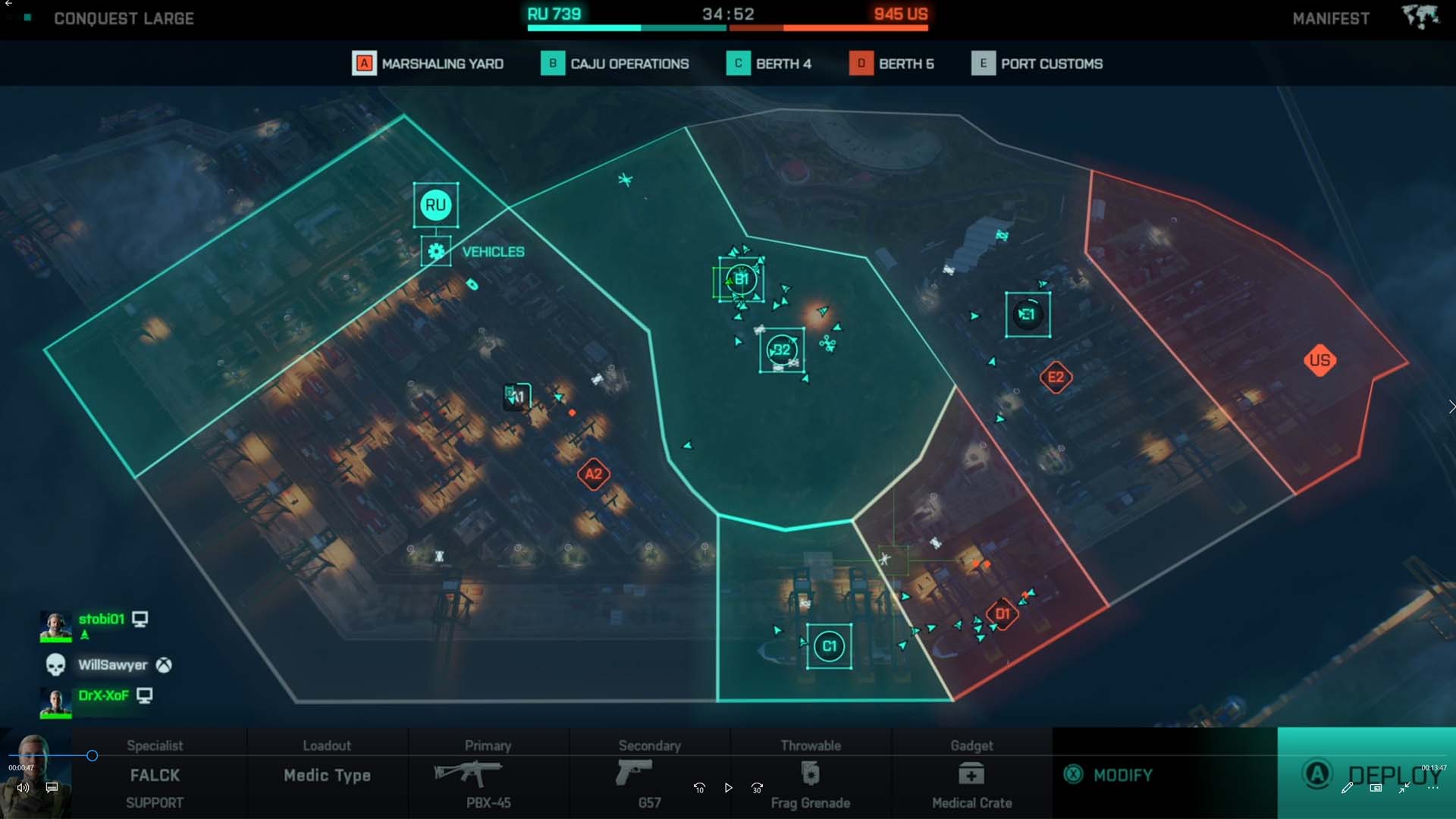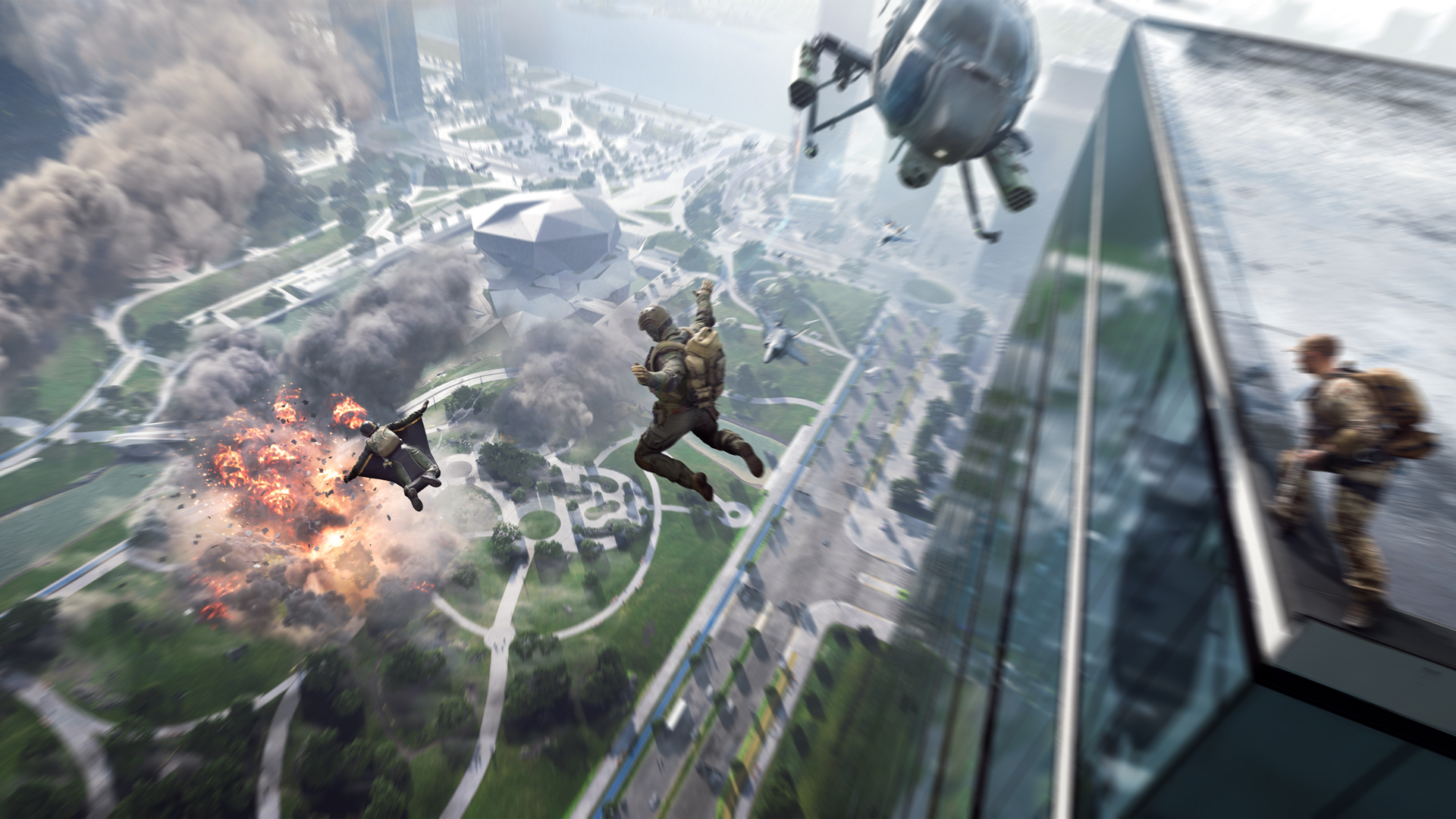GamesRadar+ Verdict
Battlefield 2042 is a strong foundation for future expansion. DICE's multiplayer-only FPS has scale and spectacle, but there are elements in need of careful refinement and optimization.
Pros
- +
+ All-Out War is spectacular
- +
+ Looks, sounds, and feels amazing
- +
+ Portal is a powerful creation tool
Cons
- -
Hazard Zone is boring
- -
Tough for solo players
- -
Classes are a big loss
Why you can trust GamesRadar+
Battlefield 2042 wants you to surrender to the spectacle. With the first-person shooter market more fractured than ever before, developer DICE has gone all-in on an expressive, expansive multiplayer design. For PC, PS5, and Xbox Series X owners, the player count has doubled from 64 to 128, and the maps are built to a truly unprecedented scale to accommodate. You are confronted by the impact of these innovations continuously, every time you are air-lifted into one of its seven combat zones.
As you disembark from the transport, you're given a second to catch your breath before the conquest begins in earnest. Seeing 63 other players rush forward in a wave, as armored vehicles crest through ranks of infantry and as fighter jets roar overhead, is truly awesome. As is knowing that somewhere, hundreds of Klicks away, another 64 players are having a similar awakening. Within minutes, the two sides will meet, and the unpredictable carnage that follows is what makes Battlefield 2042 so irresistible.
Embracing chaos

Battlefield 2042 contains three distinct multiplayer experiences: All-Out Warfare, large-scale conflicts built around expanded Breakthrough and Conquest modes; Hazard Zone, a lacklustre survival mode that can foster more intimate engagements; and Portal, a superb creation tool that will likely keep the community engaged in this live-service ecosystem for years to come.
Breakthrough is where Battlefield 2042 shines brightest. One side is assigned as the attacking force and the other as defender, with the frontline of combat shifting back and forth between specific sectors in a massive, messy war of attrition. There's something undeniably spectacular about these head-to-head battles. It's in Breakthrough where Battlefield 2042 finds a rare moment of focus, something which can't be so easily said of Conquest.
With 128 players fighting over the same objective, the scale and intensity of combat can be stunning – with scores of attacking squads aggressively pushing for inches of ground against an entrenched defensive wall. There's this desperate tension to map progression and an unwavering joy to be earned in helping your team gather momentum, a factor that helps Breakthrough supplant Conquest as Battlefield 2042's flagship mode.

DICE stripped single-player out of Battlefield 2042, but Breakthrough organically generates scenarios that are typically reserved for scripted campaigns. Your squad will instinctively assemble behind armored vehicles to take cover against entrenched snipers, you'll find yourself sprinting through thick crossfire to supply medical assistance to downed friendlies, and work within the wider coalition to expose weak points, push flanks, and blow defensive lines wide open. There's a cinematic quality to these multiplayer conflicts that is invigorating.
There's a reason Conquest has appeared in every series entry in its 20-year history: it's the ultimate expression of the Battlefield sandbox. That remains true in 2042, although the larger maps and player count have made it more chaotic and unpredictable. With play extending cross-platform, and with no in-game voice chat support at launch, Conquest can easily overwhelm solo players and frustrate less experienced squads.
Weekly digests, tales from the communities you love, and more
Battlefield 2042 has made a slight adjustment to Conquest to try and focus its action. Teams must now capture multiple control points within a sector before they are able to seize it. However, sectors change hands so quickly that it can be difficult to assess your impact on the wider conflict. Battlefield can often feel haphazard, particularly when it's difficult to identify where you're being shot from or where to focus your attention, and that's especially true here. Conquest is a great time with the right people around you, but it can be all too easy to become frustrated with so many players roaming in and out of sectors from all directions.
Time to kill

Historically, as fun as Battlefield's action can be when everything clicks into place, there are flaws in its formula – many of which return in 2042. It's still far too easy to be killed by unseen players from truly obscene distances; given the wider play spaces, long lines-of-sight, relative lack of cover, and rapid time-to-kill, once the first shot registers you're as good as dead.
As great as the weapons handle, there are just 22 of them available at launch. While there's certainly a learning curve to the unique dynamics and bullet drop of each weapon, it feels less severe than in previous installments to the series. I suspect that this has had some impact on the balance of engagements, particularly for series veterans who are already comfortable mitigating assault, marksman, and sniper rifle recoil patterns.
Thankfully, Battlefield 2042 does give you ways to adapt to natural changes in the cadence of combat. The new 'Plus' system lets you modify your primary and secondary weapons on the fly by altering unlocked attachments in the heat of battle. The ability to change scopes as you shift between environment types, or ammunition and barrels as the threat changes from infantry to vehicle, is a lot of fun. Resourceful players will appreciate the versatility this system presents, making your chosen loadout more viable in a wider variety of situations.

Of all of the changes that have been to the core Battlefield formula, the introduction of Specialists is where 2042 stumbles hardest. Battlefield has traditionally used classes as a cudgel to balance its action and teamplay, with weapons and gadgets restricted to specific roles – forcing synergy in squads. Assault rifles are no longer tied to the Assault class, nor snipers to Recon; all players can freely equip ammunition boxes, repair tools, and medkits, and the same goes for rocket launches and C4 too. It makes for a messier, more unfocused battlefield.
It can often feel as if Battlefield 2042 has sacrificed the series' focus on specialization. It's difficult to identify what role players are fulfilling, or whether the troops assembling around objective points are properly equipped to deal with emerging threats. It's also worth mentioning that each of the 10 Specialists have their own unique gadgets and traits, but few have any real utility; Mackay and Rosier are the standouts, as their Grappling Hook and Wingsuit equipment have a tangible impact on traversal.
At a time where Battlefield needed to meet its increased scale with improvements to visibility, it's disappointing that DICE has pushed away clear and communicable squad compositions. With 128 players running riot there's never been a greater need for a regular flow of ammo boxes and medkits, but that support seems harder to come by now that players are able to create loadouts built around weapon classes rather than role requirements.
Expanding the experience
It's All-Out War where most players will settle in Battlefield 2042; groups of friends gravitating toward the carnage of Conquest and everybody else into the breathtaking rhythms of Breakthrough. DICE has introduced two new ways to play here too, although one is markedly stronger than the other. Hazard Zone is a 32-player, squad-based survival mode which pits eight teams of four against one another, and roving gangs of AI soldiers, to capture and extract Data Drives.
Hazard Zone feels like the direct antithesis of what the broader Battlefield 2042 package is trying to deliver. The pacing is needlessly slow, with action taking place on maps repurposed from All-Out War – far too large to support these smaller-scale entanglements. Progression is cumbersome too, with Dark Market Credits (which are earned for successfully extracting data drives and killing enemies) used for little more than rebuilding your loadout from scratch between matches.
With the sandbox stripped down to its barest of essentials, Hazard Zone is little more than a side attraction in Battlefield 2042. While there's every chance that DICE will improve the pacing, objective, and permeance between rounds, right now it's difficult to recommend stepping foot in this game mode without a tight squad around you.

And then there's Battlefield Portal, one of the best parts of the entire 2042 package. It's a robust suite of editing and sharing tools that will let you create your own Battlefield experiences and share them with the wider community. By letting you draw on the maps, weapons, and classes of Battlefield 1942, Battlefield 3, and Bad Company 2 – all of it underpinned by the technology of 2042 – it feels like a killer way to celebrate the series' 20th anniversary and the players that have stuck with it along the way.
The web-based editor is robust, allowing for a surprising amount of nuance. You can mix elements from all of the games together or effectively create new-gen remasters of your favorite maps and modes from Battlefield's past. Portal has let me see what Rush on Bad Company 2's Arica Harbor or Valparaiso maps would be like with 128 players, and what its carnival of destruction would look like in 4K – it's incredible, by the way.
That the technology of Battlefield 2042 can be leveraged to breathe new life into the series' past like this is fantastic. While the quality of creations can differ wildly, there's real joy to be had in returning to some favorite maps and modes from the past, particularly as they are given an audio, visual, and performance boost. Portal is a mode that the community at large is going to spend months – if not years – pushing to the limit.
Solid foundations

Battlefield 2042 launches on solid ground. DICE has plans to expand its FPS over time, effectively treating it as a live service. We're obviously yet to get a sense of what that will look like, how the studio will handle a regular cadence of content releases, or progression of its battle pass, but that will all come in time.
For now, Battlefield 2042 is a good time that only gets better with friends. In its current form, those of you coming in without a squad or directly from the battle royales of this world may struggle to get a footing in the carnage, but if you can settle into the rhythms of Battlefield 2042's All-Out War you won't play anything else quite like it on new-gen systems.
Battlefield 2042 was reviewed on PC and Xbox Series X, with code supplied by the publisher.

Josh West is the Editor-in-Chief of GamesRadar+. He has over 15 years experience in online and print journalism, and holds a BA (Hons) in Journalism and Feature Writing. Prior to starting his current position, Josh has served as GR+'s Features Editor and Deputy Editor of games™ magazine, and has freelanced for numerous publications including 3D Artist, Edge magazine, iCreate, Metal Hammer, Play, Retro Gamer, and SFX. Additionally, he has appeared on the BBC and ITV to provide expert comment, written for Scholastic books, edited a book for Hachette, and worked as the Assistant Producer of the Future Games Show. In his spare time, Josh likes to play bass guitar and video games. Years ago, he was in a few movies and TV shows that you've definitely seen but will never be able to spot him in.



